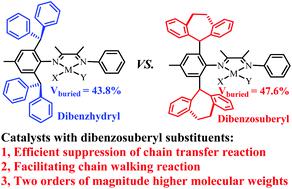当前位置:
X-MOL 学术
›
Polym. Chem.
›
论文详情
Our official English website, www.x-mol.net, welcomes your
feedback! (Note: you will need to create a separate account there.)
Efficient suppression of the chain transfer reaction in ethylene coordination polymerization with dibenzosuberyl substituents
Polymer Chemistry ( IF 4.1 ) Pub Date : 2022-06-06 , DOI: 10.1039/d2py00282e Zhou Lu 1 , Yudan Liao 1, 2 , Weigang Fan 1 , Shengyu Dai 1, 2
Polymer Chemistry ( IF 4.1 ) Pub Date : 2022-06-06 , DOI: 10.1039/d2py00282e Zhou Lu 1 , Yudan Liao 1, 2 , Weigang Fan 1 , Shengyu Dai 1, 2
Affiliation

|
The chain transfer reaction plays an important role in governing the polymer molecular weight in coordination polymerization. In this work, we demonstrate that dibenzosuberyl substituents are efficient in suppressing chain transfer reactions and significantly enhancing the molecular weight of polymers and copolymers in ethylene (co)polymerization with α-diimine Ni(II) and Pd(II) species. Herein, a family of α-diimine Ni(II) and Pd(II) complexes with dibenzosuberyl substituents were designed, synthesized and characterized. In the nickel-catalyzed ethylene polymerization, dibenzosuberyl Ni(II) catalysts exhibited high activities (level of 106 g mol−1 h−1) and yielded highly branched (80–93/1000C) polyethylenes with high molecular weights (up to 586.4 kg mol−1). On the other hand, in the corresponding palladium-catalyzed ethylene polymerization, the Pd(II) catalysts displayed moderate activities (level of 105 g mol−1 h−1) and yielded highly branched (72–113/1000C) polyethylenes with high molecular weights (up to 297.3 kg mol−1). Moreover, dibenzosuberyl Pd(II) catalysts generated highly branched (72–107/1000C) E-MA copolymers with high molecular weights (up to 78.5 kg mol−1) and high incorporation ratios (up to 9.6 mol%). As compared with the classical dibenzhydryl Ni(II) and Pd(II) catalysts, dibenzosuberyl catalysts displayed an outstanding ability to suppress chain transfer reactions and generated polymers and copolymers with 1–2 orders of magnitude higher molecular weights during ethylene (co)polymerization. The sandwich-like structure formed by dibenzosuberyl substituents was proposed to be responsible for the observed phenomenon.
中文翻译:

用二苯并琥珀酰基取代基有效抑制乙烯配位聚合中的链转移反应
在配位聚合中,链转移反应在控制聚合物分子量方面起着重要作用。在这项工作中,我们证明了在乙烯与 α-二亚胺 Ni( II ) 和 Pd( II ) 物质的(共)聚合中,二苯并琥珀酰基取代基可有效抑制链转移反应并显着提高聚合物和共聚物的分子量。在此,设计、合成和表征了一系列具有二苯并琥珀酰基取代基的 α-二亚胺 Ni( II ) 和 Pd( II ) 配合物。在镍催化的乙烯聚合中,二苯并琥珀酰基 Ni( II ) 催化剂表现出高活性(10 6 g mol -1 h-1 ) 并产生具有高分子量(高达 586.4 kg mol -1)的高度支化 (80–93/1000C) 聚乙烯。另一方面,在相应的钯催化乙烯聚合中,Pd( II ) 催化剂表现出中等活性(水平为 10 5 g mol -1 h -1)并产生高度支化的 (72–113/1000C) 聚乙烯,具有高分子量(高达 297.3 kg mol -1)。此外,二苯并琥珀酰基 Pd( II ) 催化剂可生成高度支化的 (72–107/1000C) E-MA 共聚物,其分子量高达 78.5 kg mol -1) 和高掺入率(高达 9.6 mol%)。与经典的二苯甲基 Ni( II ) 和 Pd( II ) 催化剂相比,二苯并琥珀酰催化剂在乙烯(共)聚合过程中表现出出色的抑制链转移反应的能力,并生成了分子量高 1-2 个数量级的聚合物和共聚物。由二苯并琥珀酰基取代基形成的三明治状结构被认为是造成观察到的现象的原因。
更新日期:2022-06-06
中文翻译:

用二苯并琥珀酰基取代基有效抑制乙烯配位聚合中的链转移反应
在配位聚合中,链转移反应在控制聚合物分子量方面起着重要作用。在这项工作中,我们证明了在乙烯与 α-二亚胺 Ni( II ) 和 Pd( II ) 物质的(共)聚合中,二苯并琥珀酰基取代基可有效抑制链转移反应并显着提高聚合物和共聚物的分子量。在此,设计、合成和表征了一系列具有二苯并琥珀酰基取代基的 α-二亚胺 Ni( II ) 和 Pd( II ) 配合物。在镍催化的乙烯聚合中,二苯并琥珀酰基 Ni( II ) 催化剂表现出高活性(10 6 g mol -1 h-1 ) 并产生具有高分子量(高达 586.4 kg mol -1)的高度支化 (80–93/1000C) 聚乙烯。另一方面,在相应的钯催化乙烯聚合中,Pd( II ) 催化剂表现出中等活性(水平为 10 5 g mol -1 h -1)并产生高度支化的 (72–113/1000C) 聚乙烯,具有高分子量(高达 297.3 kg mol -1)。此外,二苯并琥珀酰基 Pd( II ) 催化剂可生成高度支化的 (72–107/1000C) E-MA 共聚物,其分子量高达 78.5 kg mol -1) 和高掺入率(高达 9.6 mol%)。与经典的二苯甲基 Ni( II ) 和 Pd( II ) 催化剂相比,二苯并琥珀酰催化剂在乙烯(共)聚合过程中表现出出色的抑制链转移反应的能力,并生成了分子量高 1-2 个数量级的聚合物和共聚物。由二苯并琥珀酰基取代基形成的三明治状结构被认为是造成观察到的现象的原因。











































 京公网安备 11010802027423号
京公网安备 11010802027423号